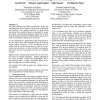Free Online Productivity Tools
i2Speak
i2Symbol
i2OCR
iTex2Img
iWeb2Print
iWeb2Shot
i2Type
iPdf2Split
iPdf2Merge
i2Bopomofo
i2Arabic
i2Style
i2Image
i2PDF
iLatex2Rtf
Sci2ools
ICSE
2001
IEEE-ACM
2001
IEEE-ACM
A Scalable Formal Method for Design and Automatic Checking of User Interfaces
The paper addresses the formal specification, design and implementation of the behavioral component of graphical user interfaces. The complex sequences of visual events and actions that constitute dialogs are specified by means of modular, communicating grammars called VEG (Visual Event Grammars), that extend traditional BNF grammars to make the modeling of dialogs more convenient. A VEG specification is independent of the actual layout of the GUI, but it can be easily integrated with various layout design toolkits. Moreover, a VEG specification may be verified with the model checker Spin, in order to test consistency and correctness, to detect deadlocks and unreachable states, and also to generate test cases for validation purposes. Efficient code is automatically generated by the VEG toolkit, based on compiler technology. Realistic applications have been specified, verified and implemented, like a Notepad-style editor, a graph construction library and a large real application to med...
| Added | 30 Jul 2010 |
| Updated | 30 Jul 2010 |
| Type | Conference |
| Year | 2001 |
| Where | ICSE |
| Authors | Jean Berstel, Stefano Crespi-Reghizzi, Gilles Roussel, Pierluigi San Pietro |
Comments (0)

